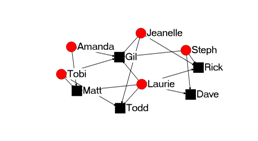

BACKGROUND
Social network analysis, or the study of the patterns of relational ties between individuals, groups and/or organizations which permits the analysis of the social structure of interaction in society, is an emerging and increasingly popular methodological and theoretical perspective in social research. Instead of accepting the overly-simple perspective that characteristics of individuals determine social structure and behaviour, social network analysis accepts as one of its primary tenets that individual behaviour is interpretable only in terms of that the constraints placed on it by the existing structure of society (see B. Wellman, 1988. “Structural Analysis: From Method and Metaphor to Theory and Substance.” In: B. Wellman and S.D. Berkowitz eds. Social Structures: A Network Approach, Cambridge University Press: Cambridge, MA:19-61).
Much of the descriptive and analytic usefulness of social network analysis is based on the unique relational data collected in various formats, typically through survey instruments. In their simplest form, these tools typically ask respondents about their ties to a listing of certain individuals, organizations, or groups. Relational data collected form these instruments is usually converted into a matrix or list format, and used as input for any of the several existing software packages designed specifically for analyzing social network data.
Dozens of papers have been published in the field over the past couple of decades, and while many are more theoretically-oriented using existing data to present new and innovative methods of analysis, many are more applied and use measurement tools uniquely designed to confront specific research questions of interest. Oddly, however, only a handful of these works actually present the measurement tools they used in their data collection efforts. This creates a certain obstacle for new students or researchers who are being introduced to social network analysis for the first time.
This site is meant to remedy this situation by providing students, researchers, practitioners and others real-world examples instruments used for the collection of social network data.
Please see the submissions page if your have any material you would like to include on this site. The success and usefulness of this site is dependent on your participation.
Design and implementation of this site was funded by the
Faculty of Arts Instructional Technology Fund at the
Content by: Todd E. Malinick